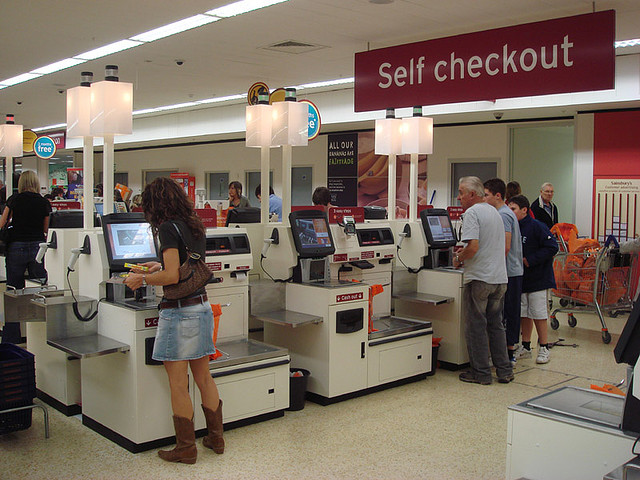The digital revolution has already signaled the shift towards digital solutions to replace analog ones of the past. Unfortunately for many, this also includes the replacing of human workers with their digital counterparts. This can most commonly be witnessed in the form of self-checkout counters that are everywhere nowadays. Albert Heijn, Hoogvliet, Decathlon, Lidl and now since 2-3 weeks in Leiden, also HEMA are rolling out these self checkout stations. These are digital stands that allow consumers to take matters into their own hands by acting as both consumer and cashier by scanning their own products and paying. As seen above, these are mostly at grocery stores where there is a regular amount of business and consumers. Usually there are 1 or 2 attendants nearby just to help those struggling with the system and to make sure everyone pays for what they’ve taken.

This essentially allows 5-6 customers pay for their goods and services with only 1-2 workers being required to be on the clock. It can be seen as a win for the costumer, as these self checkout stands are often faster and a win for the franchise/store who has to pay less workers. What about the cashiers who are now being replaced by digital technology? In the Netherlands at least, this sort of replacing of workers with digital alternatives is mostly limited to self checkout stands (based on my personal experience). In other countries (or industries), however, this implementation of digital technology reaches even further, such as demonstrated by Amazon’s widespread adoption of automation in the form of robots to do the ‘menial’ physical labour in warehouses. These robots are “more efficient and less tired” than traditional human workers, as described in a NYTimes article.
Most would assume that digital automation is only able to complete menial low-skilled labour such as sorting boxes or working a cash register, however, one AI expert estimates that even more complex occupations such as being a chef could be accomplished through the use of AI in the future. Cashiers, waiters, drivers etc.; these are all jobs that heavily involve human interaction, but not particularly specialised skill set, hence AI and digital technology could replace these completely in the future. The age of automation and digital solutions has allowed corporations to cut even more costs by investing in digital alternatives that can accomplish tasks just as good, if not better, than the current human workforce and which will pay itself off in just a few years. The change is happening right now. Foxconn, the largest electronics manufacturing company in the world, has replaced 60,000 workers with robots back in 2016. That was nearly 4 years ago. Moore’s Law dictates (in simple terms) that the computing and processing power will double every two years. Since Foxconn’s implementation of robots, processors have drastically improved and so has the research into AI.
The switch from analog to digital has brought a lot of benefits to society, research, governmental control and mass production (among many other things). As governments potentially increase minimum wages across the world, more corporations may look at implementing more automatic digital solutions in order to cut costs by not having to pay more workers than is necessary.


Recent Comments